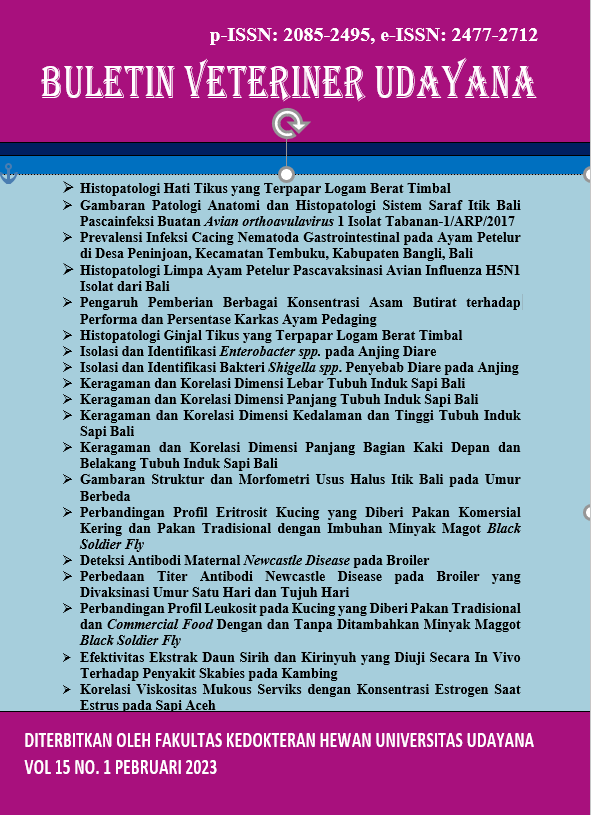DIFFERENCES OF NEWCASTLE DISEASE ANTIBODY TITER IN ONE DAY AND SEVEN DAY VACCINATE BROILER
Abstract
Newcastle Disease (ND) is a disease caused by avian Paramyxovirus type-1. Common symptoms had seen early in infection are decreased appetite, lethargy and conjunctivitis. The main strategy that can be done to prevent the emergence of ND disease is by implementing a biosecurity system and vaccination, the success of vaccination is supported by post-vaccination antibody titer examination. This study aims to compare the determination of Newcastle Disease antibody titers in broiler vaccinated at the age of one day at the factory and seven days old.This study used 30 broiler divided into three treatment groups. The first sample chickens group were not vaccinated or known as control samples (P0). The second group of chickens has vaccinated one-day ages at the factory (P1). The third group of vaccinated chickens was seventh days old (P2). Blood sampling in the P0 group was carried out starting at the age of 7, 14, 21, 28 and 35 days, the P1 group at the age of 7, 14 and 21 days and in the P2 group at the age of 14, 21 and 28 days at random (random sampling) through the brachial vein. The examination of serum antibody titers can be using the Haemagglutination Inhibition (HI) serological test. The data obtained from the serological examination results were analyzed using the statistical test of variance and regression analysis test SPSS software. The results showed that there was a significant difference in ND antibody titers in the first and second weeks after vaccination and there was no significant difference in the third week after vaccination. It is necessary to booster broilers vaccinated one day at the age of 13 days and broilers vaccinated at seven days at the age of 25 days to increase immunity again.
Downloads
References
Ardana IBK. 2011. Strategi pencegahan penyakit inefeksius pada peternakan broiler berbasis laboratorium. Bul. Vet. Udayana. 3(1): 51-59.
Aryoputranto RR. 2011. Gambaran respon kebal newcastle disease pada ayam pedaging yang divaksinasi newcastle disease dan avian influenza pada berbagai tingkat umur. Bogor. Institut Pertanian Bogor.
Gharaibeh S, Mahmoud K. 2013. Decay of maternal antibodies in broiler chickens. J. Poult. Sci. 92: 2333-2336.
Kencana GAY, Suartha N, Simbolon MP, Handayani, AN, Ong S, Syamsidar AK. 2015. Respons Antibodi terhadap Penyakit Tetelo pada Ayam yang Divaksin Tetelo dan Tetelo-Flu Burung. J. Vet. 16(2): 283-290.
Kencana GA, Suartha IN, Nainggolan DRB, Tobing ASL. 2017. Respons imun ayam petelur pascavaksinasi newcastle disease dan egg drop syndrome. JSV. 35(1): 81-90.
Kencana GAY, Suartha N, Paramita NMAS, Handayani AN. 2016. Vaksin kombinasi newcastle disease dengan avian influenza memicu imunitas protektif pada ayam petelur terhadap penyakit tetelo dan flu burung. J. Vet. 17(2): 257-264.
OIE. 2012. Newcastle disease (infektion with newcastle disease virus). Chapter 2.3.14. [25 November 2021]
Okwor GO, El-Yuguda A, Baba SS. 2014. Profile of maternally derived antibody in broiler chicks and in-ovo vaccination of chick embryo against newcastle disease. WJV. 4(1): 72-80.
Rahman MM, Sarker RD, Nooruzzaman M. 2017. Evaluation of serum antibody titer level against Newcastle disease virus in vaccinated broiler chickens. Ann. Vet. Anim. Sci. 4: 94-98.
Salam T, Muis M, Rumengan AE. 2009. Analisis finansial usaha peternakan ayam broiler pola kemitraan. J. Agr. 1: 213-217.
Sampurna IP, Nindhia TS. 2017. Metodologi Penelitian dan Karya Ilmiah. Denpasar: Fakultas Kedokteran Hewan Universitas Udayana.
Suardana IBK, Dewi NMRK, Mahardika IGNK. 2009. Respon imun itik bali terhadap berbagai dosis vaksin avian influenza H5N1. J. Vet. 10(3): 150-155.
Yoriyo KP, Adang KL, Fabiyi JP, Adamu SU. 2008. Helminths parasites of local chickens in Bauchi Stat. Nigeria. Sci. World. J. 3(2): 35-37.
Yuliani NS, Sakan GY. 2018. Respon titer antibodi pada ayam broiler yang divaksinasi ND dan diberi herbal rempah. Partner. 23(2): 696-704.





